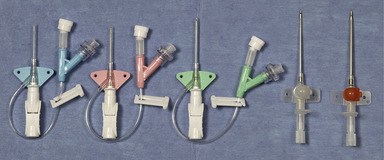CHAPTER 8. PERIPHERAL VENOUS CANNULATION
Indications67
Contraindications68
Equipment68
Practical procedure69
Post-procedure care73
Complications73
Drugs, namely opium and Crocus metallorum, were first administered intravenously to dogs by Sir Christopher Wren (1632–1723) in 1656 by use of a quill and bladder. This was first performed in humans by Johann Daniel Major (1634–1693) in 1662. Intravenous indwelling cannulae were popularized in the 19th and 20th centuries and were entirely metallic until the 1960s, which saw the introduction of plastic cannulae inserted both through and over metal stylets.
INTRODUCTION
Peripheral venous cannulation is a basic skill routinely required of doctors on a daily basis, and as such is important to master above virtually any other skill. Try to practise firstly on dummy models and then on patients before you qualify. This should minimize the discomfort for patients and increase your chances of success.
INDICATIONS
• Intravenous fluids.
• Intravenous medication.
• Intravenous electrolyte correction.
CONTRAINDICATIONS
• Lack of consent.
• Cellulitis over the area of presumed cannula insertion.
• Superficial or deep venous thrombosis.
• Ipsilateral mastectomy, i.e. a limb with impaired lymphatic drainage.
• Ipsilateral hemiparesis or contractures.
• Ipsilateral arterio-venous fistula (or potential site of arterio-venous fistula formation in pre-dialysis patients).
EQUIPMENT
• Sterile alcohol swabs.
• Tourniquet.
| Colour | Size (gauge) | Flow rate (mL/min) | Use |
|---|---|---|---|
| Blue | 22 | 36 | Patients with small veins (such as the elderly) |
| Pink | 20 | 61 | For routine i.v. fluids and medications |
| Green | 18 | 90 | |
| White | 17 | 140 | Large-bore access for rapid volume replacement (e.g. acute haemorrhage) and peripheral administration of potentially phlebotoxic drugs (e.g. amiodarone) |
| Grey | 16 | 200 | |
| Brown | 14 | 300 |
 Tip Box
Tip BoxA cannula with a smaller lumen will permit better venous flow around the cannula, thus improving haemodilution of the administered drug. Larger-gauge cannulae can also cause venous occlusion and/or intimal damage. Therefore, when intravenous access is required for routine intravenous fluids or medications, insert smaller-gauge cannulae where possible.
Stay updated, free articles. Join our Telegram channel

Full access? Get Clinical Tree




